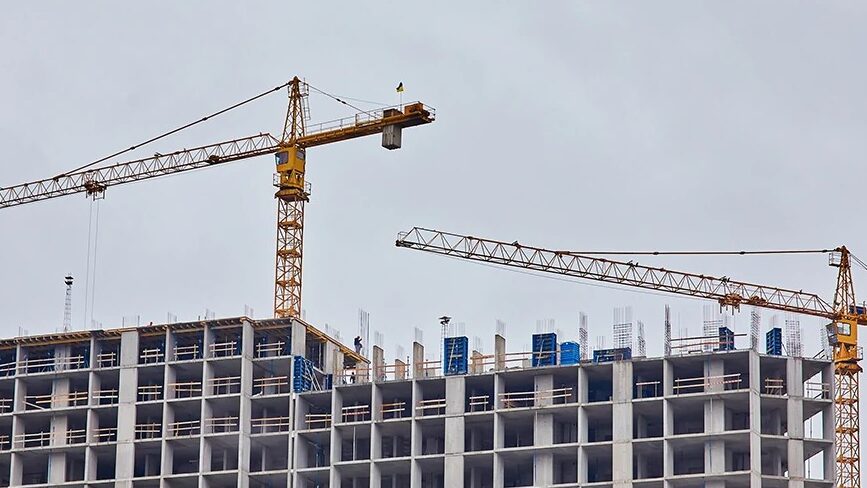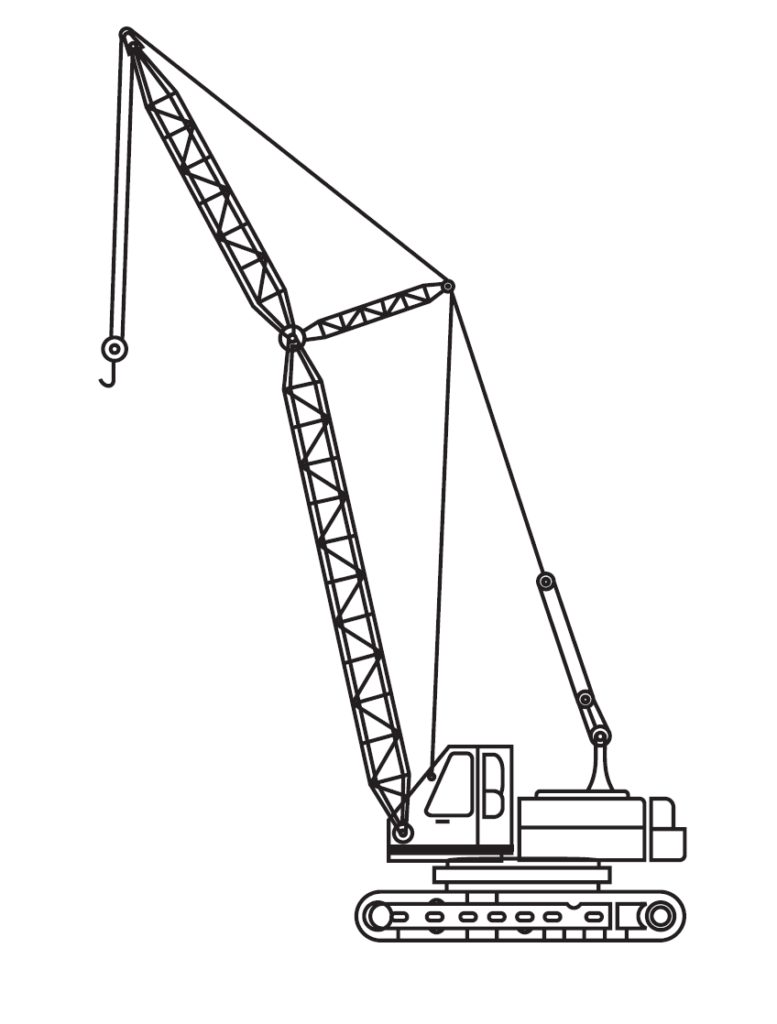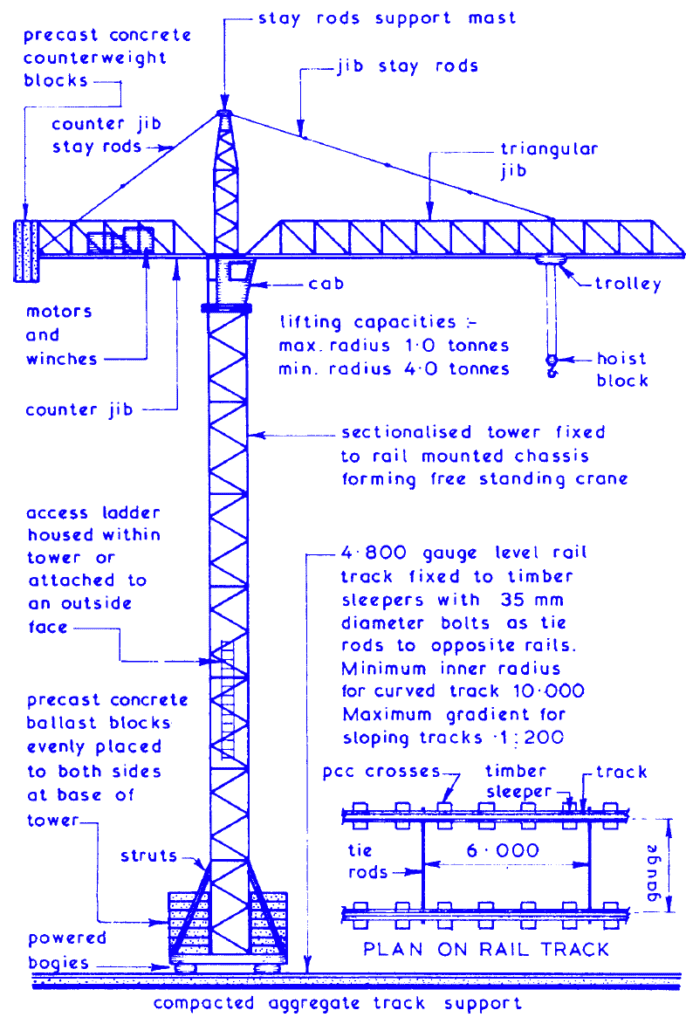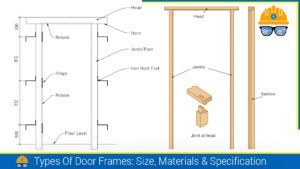In the construction industry, wheather building a simple structure or a large super structure, lifting, lowering, and transporting heavy object that includes both construction materials and other machinery to a desired location require a powerful machine known as crane. This article aims to provide insights into the various types of cranes and their applications in construction.
What is a Crane?
A crane is a machine designed to lift and move heavy objects within its operational limits by leveraging the principles of mechanical advantage. By incorporating simple machines like pulleys, levers, and hydraulic systems, cranes can handle far greater weights and also have lifting capacities ranging from 0.5 to 500 tonnes. As versatile hoisting equipment, cranes can move loads in any direction.
Types of Cranes:
There are wide range of cranes available and a choice must be made based on the loads to be lifted, height and horizontal distance to be covered, time period(s) for operations, and degree of mobility required. Crane types can range from a simple rope and pulley or gin wheel to a complex tower crane. However, most can be placed within two larger groups, namely mobile and static cranes.

Mobile Crane:
As the name implies, these cranes are equipped with wheels or tracks, allowing them to moved from one location to another. They are ideal for projects requiring flexibility and mobility to move things from one place to another quickly and easily.
Crawler Crane:
Crawler cranes also known as self-propelled crane are mounted on a wheeled chassis and have only one operator position from which the crane is controlled and the vehicle is driven. The road speed of this type of crane is generally low, usually not exceeding 30 km/h.
A variety of self-propelled crane formats are available ranging from short height lifting strut booms of fixed length to variable-length lattice booms with a fly jib attachment.
Track Mounted Cranes:
These machines can be a universal power unit rigged as a crane or a purpose-designed track-mounted crane with or without a fly jib attachment. Track mounted cranes can travel and carry out lifting operations on most sites without the need for special road and hardstand provisions but they have to be rigged on arrival after being transported to site on a low loader lorry. The latter type are usually more powerful with lifting capacities up to 45 tonnes.

Lorry Mounted Cranes:
These mobile cranes feature a telescopic boom mounted on a specially adapted truck. They operate in two modes: driving is handled from a standard front cab, while crane operation is controlled from a separate position. Their lifting capacity can be enhanced with the use of outrigger stabilizing jacks, and a fly jib can be added to reduce the approach distance to the building face.
Lorry-mounted telescopic cranes require a firm, stable surface for operation, and due to their minimal site preparation time, they are ideal for short-term hire projects.

Lorry Mounted Lattice Jib Cranes:
These cranes follow the same basic principles as the lorry mounted telescopic cranes but they have a lattice boom and are designed as heavy duty cranes with lifting capacities in excess of 100 tonnes. These cranes will require a firm level surface from which to operate and can have a folding or sectional jib which will require the crane to be rigged on site before use.

Gantry Cranes:
These are sometimes called portal cranes and consist basically of two A’ frames joined together with a cross member which transverses the lifting appliance. In small gantry cranes (up to 10 tonnes lifting capacity) the A’ frames are usually wheel mounted and manually propelled whereas in the large gantry cranes (up to 100 tonnes lifting capacity) the `A’ frames are mounted on powered bogies running on rail tracks with the driving cab and lifting gear mounted on the cross beam or gantry. Small gantry cranes are used primarily for loading and unloading activities in stockyards whereas medium and large gantry cranes are used to straddle the work area such as in power station construction or in repetitive low to medium-rise developments. All gantry cranes have the advantage of three-direction movement.
- Transverse by moving along the cross beam.
- Vertical by raising and lowering the hoist block.
- Horizontal by forward and reverse movements of the whole gantry crane
Static Crane
These types of crane are static at single location and perform operation in installed site only. The assambly of crae is need when required at the site. After completion of the work, it is mostly dismantelling and transported to new location. Are capable lifting and transporting much heavier objects.
Mast Cranes:
These are similar in appearance to the familiar tower cranes but they have one major difference in that the mast or tower is mounted on the slewing ring and thus rotates whereas a tower crane has the slewing ring at the top of the tower and therefore only the jib portion rotates. Mast cranes are often mobile, self erecting, of relatively low lifting capacity and are usually fitted with a luffing jib. A wide variety of models are available and have the advantage over most mobile low pivot cranes of a closer approach to the face of the building.
Tower Cranes:
Most tower cranes have to be assembled and erected on site prior to use and can be equipped with a horizontal or luffing jib. The wide range of models available often makes it difficult to choose a crane suitable for any particular site but most tower cranes can be classified into one of four basic groups thus:-
Self Supporting Static Tower Cranes: high lifting capacity with the mast or tower fixed to a foundation base † they are suitable for confined and open sites.
Supported Static Tower Cranes: similar in concept to self-supporting cranes and are used where high lifts are required, the mast or tower being tied at suitable intervals to the structure to give extra stability.

Travelling Tower Cranes:
These are tower cranes mounted on power bogies running on a wide gauge railway track to give greater site coverage: only slight gradients can be accommodated therefore a reasonably level site or specially constructed railway support trestle is required.

Climbing Cranes: these are used in conjunction with tall buildings and structures. The climbing mast or tower is housed within the structure and raised as the height of the structure is increased. Upon completion, the crane is dismantled into small sections and lowered down the face of the building.
All tower cranes should be left in an `out of service’ condition when unattended and in high wind conditions, the latter varying with different models but generally wind speeds in excess of 60 km p.h. would require the crane to be placed in an out of service condition thus:-
Also, read: Asphalt Paver Machine: Knowing The Importance of a Paver Machine
FAQs:
Q: What are the two primary types of cranes?
Ans: The two primary types of cranes are Static cranes and Mobile cranes.
Q: What is the working principle of a crane?
Ans: Cranes operate on the principle of using a combination of simple machines, employing the mechanical advantage to lift and move heavy loads by leveraging forces through the use of ropes, cables, and pulleys.
Q: What is a Crawler Crane?
Ans: A crawler crane is a mobile crane equipped with tracked undercarriages, offering enhanced stability and versatility on different terrains, making it ideal for heavy lifting tasks in construction projects.
References:
- Chudley, R., & Greeno, R. (2016). Building Construction Handbook (11th ed.). Routledge.
- Dwivedi, P. & Bajpai, P. (2018). Handbook of Civil Engineering. G.K. Publications (P) Ltd.
- Types of cranes used in construction | How tower cranes work. (n.d.). https://www.constructioncost.co/cranes-in-the-field-of-construction.html



